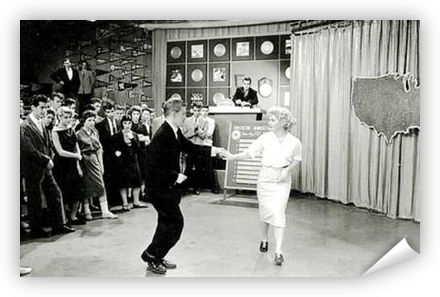
Before the moonwalk, before breakdancing, before viral TikTok moves, there was the Jitterbug—a swing dance sensation that once shook America to its core. With its wild spins, high-flying kicks, and electric energy, the Jitterbug was more than just a dance. It was a cultural revolution, a physical expression of joy and rebellion that defined a generation.
Its origins were rooted in the dance halls of the 1930s and 40s, where big band music boomed and young people tossed aside their worries for a few glorious minutes on the dance floor. But for those who grew up watching American Bandstand, the Jitterbug lived on well into the 1950s and even the early 60s—a beloved staple of youthful self-expression.
Where It All Began
The Jitterbug traces its roots to the Lindy Hop, born in Harlem’s Savoy Ballroom. It was Black dancers who first innovated this vibrant, acrobatic form of swing dancing in the late 1920s. As jazz and swing music spread across America, the dance evolved. By the late 1930s, the term “Jitterbug” became widely used, often to describe a variety of swing styles that had jittery, quick movements.
Soldiers during World War II brought the Jitterbug overseas, and by the time the war ended, the dance had become a cultural symbol of postwar celebration, hope, and the exuberance of a new era.

Jitterbug Meets Bandstand
When American Bandstand went national in 1957, it brought teen dance culture into millions of living rooms. While rock and roll was evolving, the Jitterbug still held strong. Regulars on the show, dressed in saddle shoes and crinolines, would break into Jitterbug steps with flair and familiarity.
Some of the best-loved Bandstand dancers, like Arlene Sullivan, Justine Carrelli, Kenny Rossi, and Bob Clayton, showcased Jitterbug moves with their own personal style. They weren’t just dancing—they were keeping a tradition alive.

A Dance of Emotion
The Jitterbug wasn’t just technical—it was emotional. It reflected the spirit of its time. It was fast, expressive, sometimes wild, but always joyful. It was a release. In an era where society had strict expectations of behavior, especially for young women, the Jitterbug gave teens permission to let go, to be seen, to shine.
For many who danced it, the memory of that energy is still there—in their bodies, their knees, their hearts. As one former dancer said, “You didn’t just dance the Jitterbug. You felt it.”
A Lasting Legacy
Though newer styles would eventually dominate the dance scene, the Jitterbug never truly disappeared. It survived in high school gymnasiums, wedding receptions, swing clubs, and of course—the cherished memories of those who lived through its golden era.
Today, it’s not uncommon to see younger generations rediscovering swing dance. Classes and retro nights are bringing the Jitterbug back to life, one spin at a time. For many, learning the steps is like stepping into the shoes of their grandparents, reviving a part of history that still feels electric.
Remembering the Feeling
If you ever danced the Jitterbug, or watched someone you love do it, you know it wasn’t just about the steps. It was the music, the connection, the laughter that came mid-spin, the shoes slipping just a bit too far on the polished floor. It was life, lived out loud.
In a world that changes so quickly, the Jitterbug reminds us that joy never goes out of style. The music might be old, but the feeling? Always new.
Do you remember your first Jitterbug? Or who you danced it with?
We’d love to hear your story:
📝 Share it with us here: